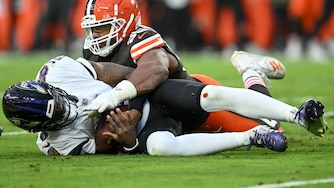SARASOTA, Fla. — There they were, the new ace and his star batterymate working together for the first time.
Corbin Burnes threw one pitch to Adley Rutschman. Shook his head. Then he threw another, same reaction.
A third pitch prompted Burnes to walk over to Rutschman. The two stood over the plate, arms flying and mouths flapping as they worked through where and how Burnes wanted Rutschman to set up. After a few minutes of discussion, they returned to their spots to resume the bullpen session.
It still wasn’t perfect. Another, more extensive talk followed after Burnes was done throwing. But this — pitchers and catchers figuring out how to work together — is a long, exhaustive process, one that starts here, during these early bullpen sessions of spring training.
The objective is for catchers and pitchers to get on the same page.
The aspiration? For them to understand each other so well that they can communicate by just a look.
Read More
“The goal is always to get to that in sync state as quickly as possible,” Rutschman said.
That first bullpen session lays the foundation. At the Orioles’ spring training complex, after long sessions in the sun, pitchers and catchers spend hours behind the scenes going through video and having conversations. They go through right-handed hitters, left-handed, framing, how they should set up, game calling, sequencing and everything else that could come up in a 162-game season.
Those talks, though, can help only so much.
“You knock those out in spring training, get those conversations out of the way,” pitcher John Means said. “I think you really only learn when they actually catch you and they see your rhythm and how your pitches go.”
It’s not just about game calling and technique. A catcher also needs to know what his pitcher needs to hear from him in a game. Backup catcher James McCann equates his role to that of a team psychologist — each player has a different personality, and it’s his job to determine how each ticks.

Last May, in Atlanta, McCann walked out to the mound and very affirmatively told Tyler Wells what he needed to do and to pull it together. There was no coddling, no words of affirmation. It was only a month into the season, and McCann, new to the team, had no way of knowing if it was going to help or hurt Wells. The Orioles, though, were down by a run and McCann thought it was worth a try.
It worked. And now McCann and Rutschman know that Wells thrives on that type of interaction.
“Some guys, you have to baby them,” McCann said. “You have to tell them how good they are, how nasty their stuff is. That’s the kind of stuff they want to hear. It doesn’t mean anything, whether a guy you get on or a guy you baby, it’s just what makes them feel good. Some guys you need to make mad; when they get mad, they pitch better.”
The Orioles have an advantage. They are expected to start the season with McCann and Rutschman, the same two catchers as last season, and have only a handful of new pitchers. Burnes is one of them, and he has already thrown to both catchers.
Closer Craig Kimbrel is also in his first camp with the Orioles, but he lives only an hour away from McCann in the offseason. The two worked together two to three times a week after Kimbrel signed in December, getting a jump on forming that relationship.
“Just his knowledge base and him being around other pitchers, just sitting around talking about different concepts and different approaches,” McCann said of those sessions. “It’s enjoyable to hear his expertise.”
These batterymates — new and old — will continue to build relationships all spring. But this process, for everyone from tenured players like Means to newcomers like Burnes, has no end date.
“You want him to be comfortable back there catching you; you want to be comfortable throwing to him,” Burnes said. “Sometimes it happens in a matter of two to three weeks. Sometimes it can take all of spring and even into the season to figure it out.”




Comments
Welcome to The Banner's subscriber-only commenting community. Please review our community guidelines.